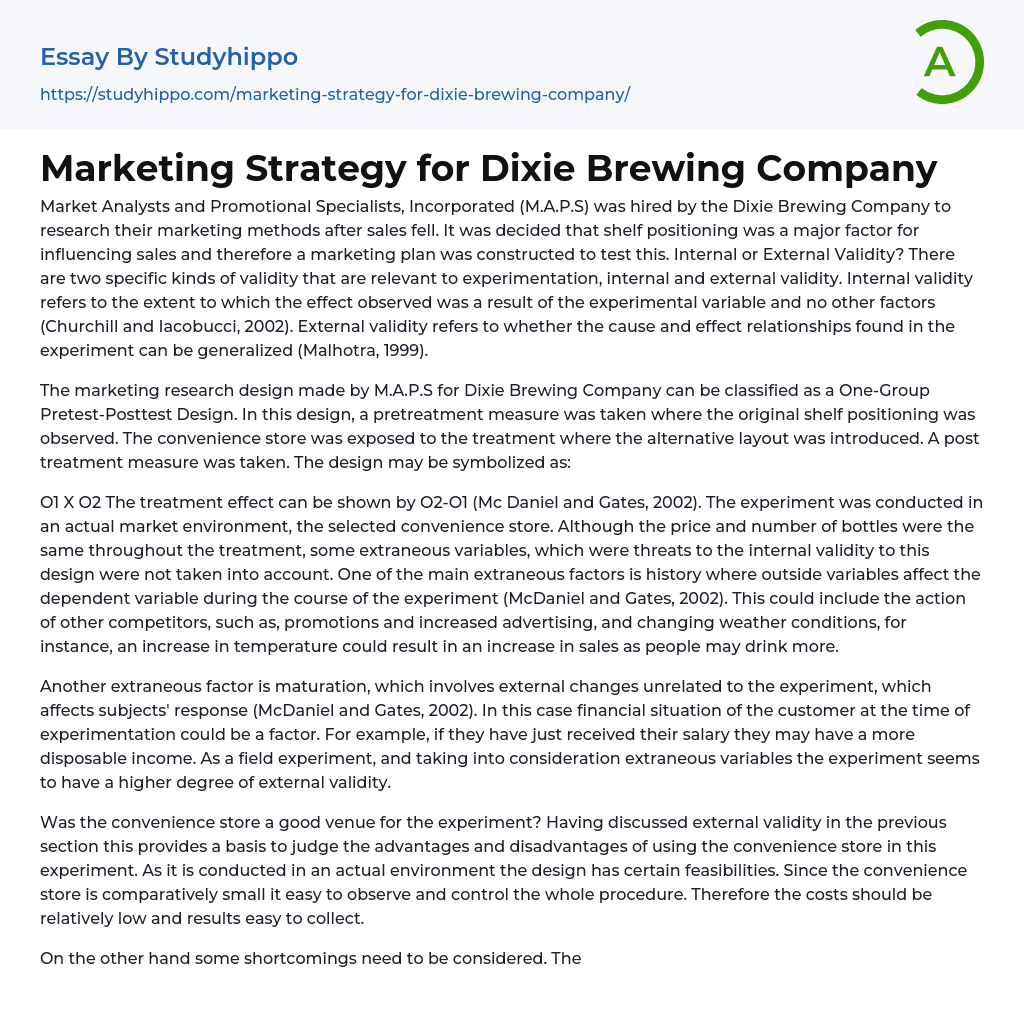

Marketing Strategy for Dixie Brewing Company Essay Example
Market Analysts and Promotional Specialists, Incorporated (M.A.P.S) was hired by the Dixie Brewing Company to investigate their marketing methods following a decline in sales. The research focused on the impact of shelf positioning on sales and a marketing plan was developed to test this hypothesis. The experiment was aimed at determining internal and external validity. Internal validity pertains to the extent to which the observed effect can be attributed solely to the experimental variable, excluding other factors (Churchill and Iacobucci, 2002). External validity considers whether the cause and effect relationships discovered in the experiment can be applied more broadly (Malhotra, 1999).
The marketing research design conducted by M.A.P.S for Dixie Brewing Company is categorized as a One-Group Pretest-Posttest Design. This design involved taking a pretreatment measure to observe the original shelf positioning. The convenience store
... was then exposed to a treatment where an alternative layout was introduced. A post-treatment measure was taken. This design can be represented as:
O1 X O2. Additionally, the treatment effect can be determined by calculating O2-O1 (McDaniel and Gates, 2002). The experiment took place in a real market environment, specifically a selected convenience store. While the price and quantity of bottles remained consistent throughout the treatment, certain extraneous variables, which pose threats to the internal validity of this design, were not considered. One of the main extraneous factors is history, where external variables influence the dependent variable during the course of the experiment (McDaniel and Gates, 2002). These external factors may include actions taken by competitors, such as promotions and increased advertising, as well as changing weather conditions. For example, higher temperatures could lead to an increase in sales as people tend t
consume more beverages.
Maturation, a factor beyond the control of the experiment, can influence participants' responses by referring to external changes (McDaniel and Gates, 2002). These changes may include factors like the financial circumstances of customers during the study. For example, if they have recently received their salary, they might have more disposable income. Due to the existence of these external variables and the experimental nature of this field research, it appears to possess a greater level of external validity.
Having discussed external validity in the previous section, we can now evaluate the suitability of using a convenience store as an experimental location. Conducting the experiment in an actual environment provides practical advantages. Due to the compact size of the store, it is convenient to observe and oversee the entire procedure. This ensures relatively low costs and ease in collecting results.
However, it is important to acknowledge certain limitations in the study. The chosen suburban region may not accurately represent various real-world locations, including differences in consumer demographics between suburban and metropolitan areas. It is also crucial to consider disparities between convenience stores and supermarkets. While spontaneous purchases are common at convenience stores, regular purchases are typically made at supermarkets. Therefore, people's buying habits may vary depending on the type of store they visit. Supermarkets offer a wider selection of beer brands, posing potential stronger competition for Dixie Brewery.
The effectiveness of the marketing design is evaluated by analyzing the advantages and disadvantages of the experiments. The sales of the seven brands of beer after the implementation of the M.A.P.S plan are depicted in the graph shown in appendix 1.0. Dixie, Bud, and Miller had the highest sales,
while Dixie Light and Coors Light had the lowest sales. The hypothesis of this experiment was that the placement of brands on a display would have an impact on sales.
However, the graph clearly indicates that there are external factors influencing the results as it generally caused a decrease or stagnation in sales. On average, Miller, Bud, and Dixie Light all decreased by 1.7%, while Coors and Coors Light remained steady. There were two exceptions to this trend: Dixie and Miller Lite experienced an increase in sales. However, Dixie saw a fivefold increase compared to Miller Lite, making it the top-selling brand overall. It is important to consider other external influencing factors, separate from shelf positioning and location of the beers, that could impact sales. These factors may include previous advertising, price advantage, packaging design, and taste - all of which can affect the consumer and subsequently impact the sales hierarchy from Dixie down to Dixie Light.
- Competition essays
- Effective Leadership essays
- Leadership Styles essays
- Public relations essays
- Planning essays
- Mission Statement essays
- Outsourcing essays
- Swot Analysis essays
- Business Analysis essays
- Business Plan essays
- Strategic Management essays
- Strategic Planning essays
- Reasoning essays
- Community Development essays
- Negotiation essays
- Experiment essays
- Explorer essays
- Hypothesis essays
- Observation essays
- Qualitative Research essays
- Research Methods essays
- Theory essays
- Advertisement essays
- Advertising essays
- Anheuser-busch essays
- Audience Theory essays
- Brand essays
- Brands essays
- Competitor Analysis essays
- Consumer essays
- Detergent essays
- Marketing Management essays
- Marketing Mix essays
- Marketing Plan essays
- Marketing Research essays
- Marketing Strategy essays
- New Product Development essays
- Point Of Sale essays
- Price essays
- Procurement essays
- Product essays
- Product Differentiation essays
- Product Placement essays
- Promotion essays
- Promotion And Marketing Communications essays
- Research Design essays
- Retailing essays
- Trademark essays
- Accounting essays
- Andrew Carnegie essays



